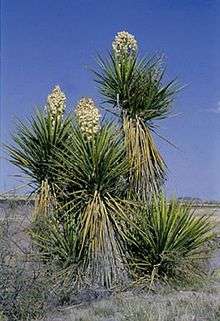Yucca faxoniana
Yucca faxoniana is a bladed evergreen shrub of the genus Yucca. It is known by the common names Faxon yucca,[3] Spanish dagger,[3] and giant dagger.[4]
| Spanish dagger | |
|---|---|
 | |
| Blooming, in Chihuahuan Desert habitat. | |
| Scientific classification | |
| Kingdom: | Plantae |
| Clade: | Tracheophytes |
| Clade: | Angiosperms |
| Clade: | Monocots |
| Order: | Asparagales |
| Family: | Asparagaceae |
| Subfamily: | Agavoideae |
| Genus: | Yucca |
| Species: | Y. faxoniana |
| Binomial name | |
| Yucca faxoniana | |
| Synonyms[2] | |
| |
Taxonomy
The species has been called Yucca torreyi – a name given in 1908 by John Shafer.[1] The epithet commemorates John Torrey, a 19th-century American botanist who designated this as a new variety in 1859.[5] Y. torreyi is now regarded as an illegitimate name; however sources differ as to the correct name, using either Yucca treculeana Carrière[6] or Y. faxoniana.[1]
Distribution
Yucca faxoniana is native to the Chihuahuan Desert region of northern Mexico, southern New Mexico, and southwestern Texas. Its range is centered around Big Bend National Park in the central Rio Grande valley in the Chihuahuan Desert. It is found mainly in the Mexican states of Chihuahua and Coahuila, but also minor locales of Durango and Nuevo León. It does not occur in the upper Rio Grande Basin section in central New Mexico, nor the lower third of the Rio Grande Valley towards the Gulf of Mexico.[3]
Description
The plant generally is a multitrunked shrub 3–10 feet (0.91–3.05 m) in height. They can be single trunked and tree-like to 20 feet (6.1 m) tall. The bladed leaves range from 2 to 4.5 feet (0.6 to 1.4 m) in length. The flowers, ivory to creamy white and bell shaped, are on a flower head up to 2 feet (0.6 m) long.[5]
Flowers, pollinated by moths of the genus Tegeticula, bloom typically in April.[4] The plant produces sweet, pulpy, oblong fruits.[4]
Uses
Native Americans used the fruit as a food source—raw, roasted, or dried and ground into meal.[7] They also used the plant leaves as a fiber in basketry, cloth, mats, ropes, and sandals.[7][5] The roots were used as a red pattern element in Apache baskets.[8]
References
- "Yucca faxoniana". World Checklist of Selected Plant Families. The Board of Trustees of the Royal Botanic Gardens, Kew. Retrieved 27 February 2012.
- "The Plant List: A Working List of All Plant Species". Retrieved 26 January 2014.
- "Yucca faxoniana". Germplasm Resources Information Network (GRIN). Agricultural Research Service (ARS), United States Department of Agriculture (USDA). Retrieved 2 January 2018.
- Morey, Roy (2008). Little Big Bend : Common, Uncommon, and Rare Plants of Big Bend National Park. Lubbock: Texas Tech University Press. p. 40. ISBN 9780896726130. OCLC 80359503.
- NPIN — Johnson. Accessed September 15, 2012
- Flora of North America Editorial Committee, ed. (1982 onwards), "Yucca treculeana", Flora of North America, Oxford University Press Check date values in:
|date=(help) - Little, Elbert L. (1994) [1980]. The Audubon Society Field Guide to North American Trees: Western Region (Chanticleer Press ed.). Knopf. p. 335. ISBN 0394507614.
- University of Michigan - Dearborn: Native American Ethnobotany — Yucca torreyi Accessed 9.15.2012
- Little. Atlas of United States Trees, Volume 3, Minor Western Hardwoods, Little, Elbert L, 1976, US Government Printing Office. Library of Congress No. 79-653298. Map 209, Yucca torreyi.
External links
| Wikimedia Commons has media related to Yucca faxoniana. |